(February 1951 – April 1951: Young Romance #30 – #32, Young Love #18 – #20)

Number of Romance Titles 1947 – 1952 (the period covered in this chapter is shaded in blue)
Besides Young Romance and Young Love, Simon and Kirby were also producing Black Magic and Boys’ Ranch during this period. Jack Kirby supplied some covers for Headline and Justice Traps the Guilty so it is possible that Joe and Jack still had something to do with the Prize crime titles as well. However Kirby, Draut and Starr, artists important to the other Simon and Kirby productions, did not appear in the crime titles. That plus the lack of a Simon and Kirby production cartouche seems to indicate that Headline and Justice Traps the Guilty were no longer produced by Joe and Jack. Romance comics in general were just starting to rebound from the relative low that followed the love glut. However with more then 45 titles, romance comics were still a lucrative part of the industry. Since both Young Romance and Young Love were both monthly titles it can be presumed that they were still selling quite well.

Young Romance #31 (March 1951) “One Way to Hold Him”, art by Jack Kirby
Since Joe Simon did not do much penciling anymore, Jack Kirby was by one definition the primary artist for the studio. Jack would provide the cover art that was still appearing on Young Love (Young Romance had converted back to using photographic covers). The all important lead stories for Young Romance were all done by Kirby. At 12 to 14 pages long, Jack’s lead stories for YR were longer then the work by any other studio artist (a maximum of 9 pages). But if the primary artist is considered the one producing the greatest number of pages of art, Kirby was no longer the primary romance artists. During this period Kirby produced 55 pages of romance art while Mort Meskin did 66 pages. Jack’s work for Boys’ Ranch #3 (February) meant that for February Jack produced the greatest number of pages in the studio for all genres but by April that was no longer true and Mort would take the lead.
About three and a half years since the start of Young Romance and Kirby is still finding ways to put special interest into his romance stories. Jack could write a story without action but he certainly like to add it when possible. Who else would use the rough and tumble roller derby world to tell a love story. I often wonder how the original teenage girl readers thought of Jack’s stories but for the modern comic reader there is no question that Kirby’s romance stories are fascinating reads.
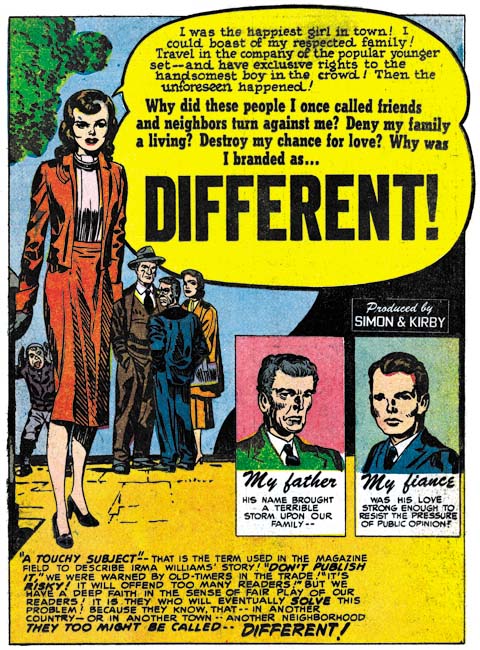
Young Romance #30 (February 1951) “Different”, art by Jack Kirby
Jack Kirby was not averse to using a love story to tackle social themes as well. “Different” is not really about romance but about intolerance instead. Initially when the family moved into the neighborhood they were well received. Only after the visit of the grandparents reveals that the family’s original name had been Wilheims did the community turn against them. Love is just a background to the story of initial acceptance followed by rejection based only on the towns prejudiced perception of the family’s background.
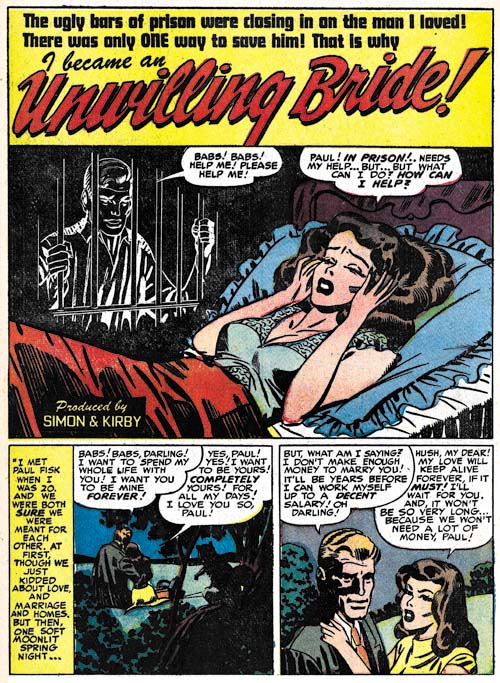
Young Love #18 (February 1951) “Unwilling Bride”, art by Mort Meskin
As discussed above, it was during this period that for the first time Mort Meskin output exceeded Jack Kirby’s. Meskin’s art production rate is all the more remarkable considering that Mort did all his own inking while Jack’s work was mostly inked by others. I wish the original art for the splash from “Unwilling Bride” was available as I would love to know how the negative figure of the jailed man was done. The spotting looks like it was brushed with white ink but I would think it would have been difficult to work white over a black background. Would Simon and Kirby have agreed to the extra expense to make a negative stat? However it was done it provides an effective way to put an image to the troubled girl’s thoughts.
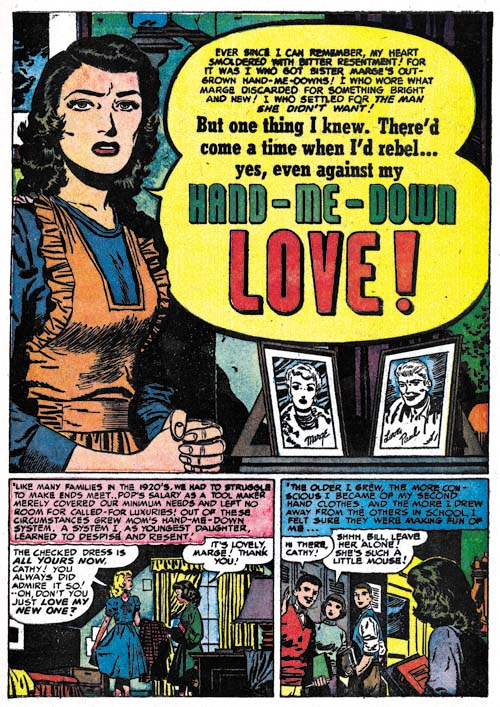
Young Romance #32 (April 1951) “Hand-Me-Down Love”, art by Bill Draut
Once again Bill Draut takes third place in the amount of work provided; 6 stories with 45 pages.
Previously Bill Draut’s splash art seemed to be in a bit of a rut; not bad but not particularly exciting. Perhaps because of his work in the new Black Magic title Draut seems to have his mojo working again. Whatever the reason Bill has some nice splashes during this period. “Hand-Me Down Love” is a confessional splash which makes me suspect that it was originally meant to be the lead story for Young Love but was moved to Young Romance instead. Since Kirby was doing all the lead stories in Young Romance Draut’s work then became one of the backup stories. Like many of Kirby’s romance splashes at the time there really is not much going on but what is presented tells a whole story. The woman’s apron identifies her as a housewife. The drab background with a wall having small flaws indicates her humble surroundings. Two photographs should be her loved ones. The man obviously would be her husband but what can be made of the woman? While the splash tells a story it purposely leaves some things unanswered to entice the viewer to read the story.

Young Romance #31 (March 1951) “The Things You’re Missing”, art by Marvin Stein
The fourth most used artist was Marvin Stein with 4 stories and 32 pages. Stein would produce some nice work for the crime titles in the future but at this point his style is a bit clumsy. Some of Marvin’s characteristic traits can be found at this earlier stage, such as the shallow depth to the face of the man in the splash. When inking his own work Stein was always a bit rough but at this point his brush also lacks the assurance he would eventually gain. Without that confidence his inking just looks as clumsy as his pencil work.
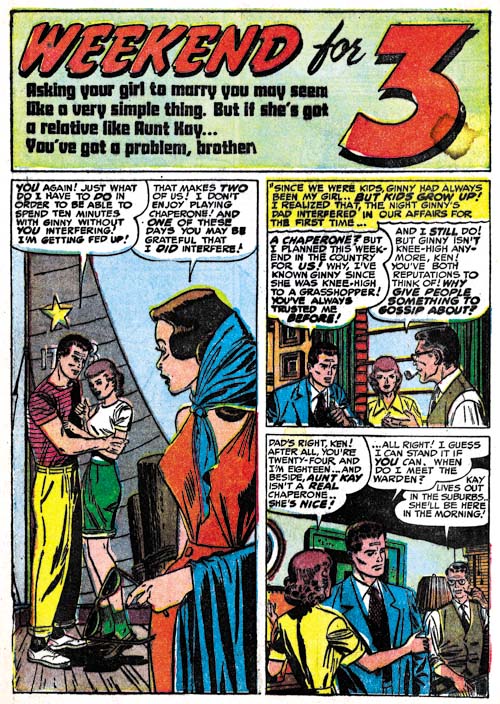
Young Romance #30 (February 1951) “Weekend For 3”, art by Leonard Starr
For whatever reason, Leonard Starr only provided a single story in the period covered in the last chapter but now he does 3 stores with 22 pages. Starr seems to have completely abandoned the tall and very narrow panels that he had previously favored. Occasionally he would divide a panel row into three panels and even more rarely extend the height slightly but the panels never become as narrow as before. For the most part now Starr adhered to a standard panel layout of 3 rows with 2 panels per row. Leonard still likes to use a vertical splash as for example “Weekend For 3”.

Young Love #18 (February 1951) “The Cave Man Type”, art by Leonard Starr
It was not just Starr’s panel layouts that were evolving. I mentioned in the Chapter 12 how Leonard had begun using a sultrier female along with the more pixie look his females previously had. In “The Cave Man Type” Starr uses what was for him a very different type of man.
My database indicates that February 1951 was when Starr would do his last work for Simon and Kirby until 1954 (and I have gone back to verify the attribution of the two 1954 pieces). But originally my database only included a single Starr work for February but with this recent review I now add two more. Considering that Starr stopped providing signatures on his later S&K work and that his style was changing I wonder if I will find more of his work when I write the next couple of chapters to this serial post?
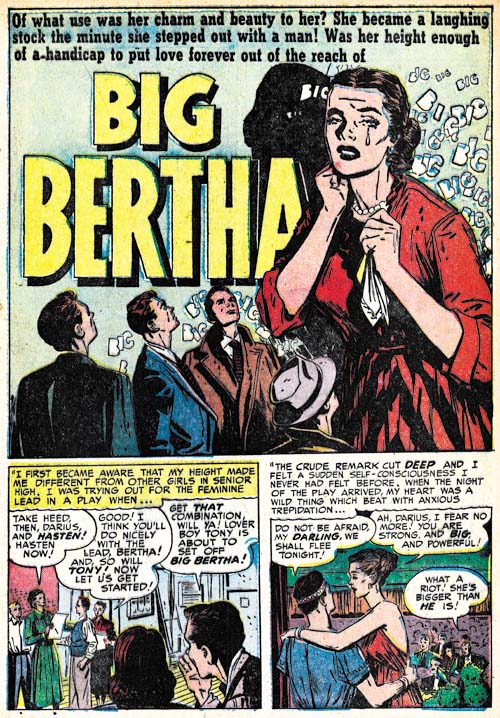
Young Love #20 (April 1951) “Big Bertha”, art by John Prentice
“Big Bertha” from YL #20 marks the first appearance in a Simon and Kirby production of work by John Prentice. My previous short biography on John Prentice (John Prentice, Usual Suspect #3) is seriously flawed* and incomplete and I really should put together a better one. Prior to coming to work for Joe and Jack, Prentice had been working for Hillman and perhaps some other publishers as well. Prentice shared an apartment with Starr so perhaps Leonard aided John in getting work from Simon and Kirby. Most artists that worked for Simon and Kirby had adopted (directly or indirectly) aspects of Milt Caniff’s style but John was greatly influenced by Alex Raymond. So much so that when Raymond died suddenly in 1956, Prentice was able to easily take over his syndication strip Rip Kirby. John’s arrival in the S&K studio filled a significant gap created when Bruno Premiani left. Artists would come and go in Joe and Jack’s studio, but the presences of Bill Draut, Mort Meskin, John Prentice, and of course Jack Kirby meant that all Simon and Kirby productions would have a healthy and interesting combination of artists.

Young Love #19 (March 1951) “Later Then You Think”, layout by Jack Kirby
I have been able to provide attributions for all of the romance work during the period covered by this chapter with the exception of “Later Then You Think”. This looks like the work of some minor artist working from layouts provided by Jack Kirby. Normally when I describe a work as based on Kirby layouts I am uncomfortable using that term because it was obvious that what Jack had provided were very tight in some places. In this particular case that is not true; the artist style is present throughout and no parts have an overly Kirby look. The only exceptions are the photographs in the splash panel that totally look like they were done by Jack. Interestingly the entire story is inked in the Studio Style; shoulder blots, abstract shadow arches, and picket fence crosshatching are found throughout.
Footnotes:
* The most serious error in my previous post on John Prentice is my attributing to him “Two-Timer” from Young Love #4 a piece that I now questionably credit to Bruno Premiani.
Chapter 1, A New Genre (YR #1 – #4)
Chapter 2, Early Artists (YR #1 – #4)
Chapter 3, The Field No Longer Their’s Alone (YR #5 – #8)
Chapter 4, An Explosion of Romance (YR #9 – #12, YL #1 – #4)
Chapter 5, New Talent (YR #9 – 12, YL #1 – #4)
Chapter 6, Love on the Range (RWR #1 – #7, WL #1 – #6)
Chapter 7, More Love on the Range (RWR #1 – #7, WL #1 – #6)
Chapter 8, Kirby on the Range? (RWR #1 – #7, WL #1 – #6)
Chapter 9, More Romance (YR #13 – #16, YL #5 – #6)
Chapter 10, The Peak of the Love Glut (YR #17 – #20, YL #7 – #8)
Chapter 11, After the Glut (YR #21 – #23, YL #9 – #10)
Chapter 12, A Smaller Studio (YR #24 – #26, YL #12 – #14)
Chapter 13, Romance Bottoms Out (YR #27 – #29, YL #15 – #17)
Chapter 14, The Third Suspect (YR #30 – #32, YL #18 – #20)
Chapter 15, The Action of Romance (YR #33 – #35, YL #21 – #23)
Chapter 16, Someone Old and Someone New (YR #36 – #38, YL #24 – #26)
Chapter 17, The Assistant (YR #39 – #41, YL #27 – #29)
Chapter 18, Meskin Takes Over (YR #42 – #44, YL #30 – #32)
Chapter 19, More Artists (YR #45 – #47, YL #33 – #35)
Chapter 20, Romance Still Matters (YR #48 – #50, YL #36 – #38, YB #1)
Chapter 21, Roussos Messes Up (YR #51 – #53, YL #39 – #41, YB #2 – 3)
Chapter 22, He’s the Man (YR #54 – #56, YL #42 – #44, YB #4)
Chapter 23, New Ways of Doing Things (YR #57 – #59, YL #45 – #47, YB #5 – #6)
Chapter 24, A New Artist (YR #60 – #62, YL #48 – #50, YB #7 – #8)
Chapter 25, More New Faces (YR #63 – #65, YLe #51 – #53, YB #9 – #11)
Chapter 26, Goodbye Jack (YR #66 – #68, YL #54 – #56, YB #12 – #14)
Chapter 27, The Return of Mort (YR #69 – #71, YL #57 – #59, YB #15 – #17)
Chapter 28, A Glut of Artists (YR #72 – #74, YL #60 – #62, YB #18 & #19, IL #1 & #2)
Chapter 29, Trouble Begins (YR #75 – #77, YL #63 – #65, YB #20 – #22, IL #3 – #5)
Chapter 30, Transition (YR #78 – #80, YL #66 – #68, YBs #23 – #25, IL #6, ILY #7)
Chapter 30, Appendix (YB #23)
Chapter 31, Kirby, Kirby and More Kirby (YR #81 – #82, YL #69 – #70, YB #26 – #27)
Chapter 32, The Kirby Beat Goes On (YR #83 – #84, YL #71 – #72, YB #28 – #29)
Chapter 33, End of an Era (YR #85 – #87, YL #73, YB #30, AFL #1)
Chapter 34, A New Prize Title (YR #88 – #91, AFL #2 – #5, PL #1 – #2)
Chapter 35, Settling In ( YR #92 – #94, AFL #6 – #8, PL #3 – #5)
Appendix, J.O. Is Joe Orlando
Chapter 36, More Kirby (YR #95 – #97, AFL #9 – #11, PL #6 – #8)
Chapter 37, Some Surprises (YR #98 – #100, AFL #12 – #14, PL #9 – #11)
Chapter 38, All Things Must End (YR #101 – #103, AFL #15 – #17, PL #12 – #14)


I got the impresion from the AE interview with one of Simon and Kirby’s writers that he and his partner were often called in with Jack and Joe to co-plot a story. So I woul think that a story set in the world of competative skating could be written by someones else than Jack Kirb, but either elaborated on in a story conference or during the drawing or both. The Different story from what I have read about it, seems like a good candidate to have been written by Jack and Joe themselves.
The face of the guy in the third panel of the Meskin story looks like nothing have ever seen him do. It would make me think that he may have been inking someone else’s work, bt the secod panel does have his tell-tale caption box on the side (as he apparently didn’t like blong panels as much as square ones). At the least it is an untypical sample of his style at that time.
I agree with your asessment of Later than you think, but I would suggest Jack had a last go at it when it was inked, adding maybe a better picture in the picture frame and some additional inking in the third panel, such as the abstract arch and shuler blotches as well as some obviously added on frilly business on the girl’s coat. as for the artist involved, the thin lines first suggested Vic Donahue to me, but when I went through your posts I found that it even resembles Giunta and Stallman’s The Life of The Part even more. The face of the driver has that Severin-look that some of George Gregg’s work. So it’s a real mystery.
I think Ger is remembering the interviews wrong. It’s the other way around. It was Kirby and to a lesser degree Joe Simon who often plotted stories for the other writers here are the relevant quotes from the two AE interviews.
Many people don’t know what a prolific writer Kirby was. Kim Aamodt was identified by Alex Toth as the finest writer he ever worked with. Walter Geier worked at the Simon and Kirby studio at the same time as Aamodt. Gil Kane is a well known gold and silver age artist, and writer.
KIM AAMODT
Aamodt:Well Simon and Kirby wrote the plots. They sat there and wrote them, and that’s what we followed.
Aamodt: Jack did more of the plotting than Joe. Jack’s face looked so energized when he was plotting that it seemed as if sparks were flying off him.
Aamodt: Joe was good, but not as creative as Jack was. Joe had his own ideas though. I always thought that Joe Simon was the businessman and Jack Kirby was the artist.
Aamodt: I remember Jack Kirby was very good at making up titles. I remember giving him a lame title, and Jack said,” No. We’re going to call it ‘Under the Knife.’ ” It was a surgical story. I was impressed that Jack came up with titles so quickly.
Aamodt: I really sweated out plots, unlike Jack Kirby. Jack just ignited and came out with ideas, and Joe’d just kind of nod his head in agreement.
Aamodt: Joe was on the ground, and Jack was on cloud nine. Jack was more of the artist type; he had great instincts.
WALTER GEIER
Geier: Every time I went up there I saw both of them(Simon and Kirby). And they always gave the writers the plots. Jack Kirby was great about that; he always came up with the plots. Jack had a fertile mind.
Geier: Joe used to sit there when the writers came in for conferences. They sat there and made up the plots for the writers. Jack did most of that. Joe would say something once in a while, but Jack was the idea man.
Geier: Joe didn’t talk much. He could come up with decent plots, but it was usually very sketchy stuff. A lot of times Joe would say, ” Awww…you figure out the ending.” Jack would give me the ending, because he was good at figuring out stories. It was not hard to work with Jack.
Geier: They were Jack’s plots. I just supplied the dialogue.
GIL KANE
Kane: Joe was involved in the creative process and he was the one who made all the deals. Joe would ink all the splashes and occasionally he would pencil a job and ink it. He didn’t write-it was Jack who wrote. Jack would either write a script or get one and adjust it as he saw fit.
Kane: Simon was business-like. He did all the handling, all the talking, he did all the standing. Jack was always sitting and working. Jack would take the scripts and he’d either write them or re-write them. Jack was simply a workhorse who never sweated. It just came to him.
GROTH: One other question about Simon: He was an artist too, and he always maintained that his and Kirby’s collaboration was 50/50.
KANE: No, that’s absolutely untrue. First of all there was a guy named Charles Nicholas, who used to do all of the inking that Jack and Simon didn’t do. Simon used to do splashes and covers, but Charles Nicholas, after a while, did the inside of all of the stuff. We know that Jack penciled every single thing they did. Simon only inked a fraction of what they did. Simon was an effective inker on those splashes and everything, he developed a very elaborate style. However, Jack was his own best inker, he was superb. He did most of the Captain America splashes.
GROTH: Do you know who wrote that stuff?
KANE: Fran Herron who was one of the editors up at Fawcett. He ultimately moved over to DC. He wrote some of that stuff. Jack wrote some of it, he used to write all the Vision stories. Jack told me he used to write, pencil, and ink practically a whole Vision story in one day when he was at Marvel.
And the debate goes on. Although it is nice to see these quotes together and Patrick clearly took more time to make his point than I did (for which I thank him), I feel it only proves my point. Namely, that Harry implies that Kirby ‘wrote’ the roller skater story and I don’t think it should be called writing unless you sit down and type out or letter the words – for which Simon and Kirby often employed outside talent. Gil Kane’s remark that Kirby often ‘enhanced’ scripts was playing through my head as well. Semantics, schmemantics. I have that book and it is a great story. I agree with harry that Kirby had a lot to do with that. Either he plotted it or he reworked the script (maybe even after he plotted it as well). He just didn’t ‘write’ it in the common sense just like any writers couldn’t say they did.
Ger,
I think perhaps you are placing too placing too much of your own definition of the word “write”. Yes Joe and Jack employed writers to come up with scripts. But as Patrick has pointed out Kirby was certainly involved in the plotting. But most importantly, as I have pointed out often in this blog and in particularly in this serial post, Jack would often re-write what he got back to make them his own. Why else would the stories Jack drew be so different from the stories drawn by other studio artists. As such I feel it is fair to say Jack wrote his own stuff. That does not imply that he did not have help.
Patrick,
I would caution about taking Kane’s statements on face value. His remarks about events that he could not possibly have seen makes everything he says suspect. Kane came in contact with Simon and Kirby when they were working for DC and as such he could not possibly know who did what in Captain America.
Ger, and Harry: It was easy for me to post those quotes. I have a file where I keep a long list of Kirby quotes taken from interviews.
It is my impression that the quotes from Aamodt and Geier are describing Simon and Kirby giving them plots for stories they would be writing for other artists in the shop. Go back and look at the full interview.
Notice that Geier is saying “they always gave the writers the plots” so it’s not just two writers it’s all the writers Geier is mentioning. Since as Harry has pointed out Kirby wasn’t doing all that much penciling it really doesn’t make sense that Aamodt and Geier are talking about the lead stories does it? There isn’t the slightest indication that they are talking about stories to be penciled by Kirby.
I find it very easy to believe that Kirby pitched plots to other writers. In fact I find it impossible to believe that he didn’t, Kirby couldn’t stop himself. There is a mountain of evidence that he did so. Robert Bernstein has described that while he was writing Superman in the 50’s and early 60’s he would station himself on the train platform, and wait until he saw Kirby approaching so that he could take the same train out of Manhattan. Bernstein said on the ride home Kirby would give him a enough story ideas to last a couple of months. Stan Lee had Kirby layout and plot stories for other artists, and Stan describes Kirby sitting in on a plot conference with Wally Wood for the Stilt Man story in a Daredevil letter page. I don’t think anyone but Kirby and Simon had a thing to do with almost any of the Simon&Kirby penciled lead stories. Take a look at the dialogue in the Best of book, On a Story like “The Savage In Me” it just screams Kirby. Kirby’s over the top florid dialogue is the perfect mirror of his art.
Remember that the DC editors considered Kirby’s artwork to be ugly, and couldn’t understand why it was popular.
Harry, you are correct about Kane’s comments concerning Simon&Kirby at Timely. Kane says they are based on what Kirby told him so they are hear-say.
I wonder if Harry can place the story Aamodt mentions Kirby contributing a title for “Under the Knife” who was the penciler?
I went back and checked the interviews with Geier and Aamodt. They do mention working on at least some stories penciled by Kirby, so I was wrong about that. Aamodt and Geier describe Simon&Kirby as giving them for all the stories they wrote to be illustrated by the stable of artists. After Kirby or Simon gave Aamodt a plot Simon would say to him, “make it five or six pages.” Neither Aamodt or Geier can remember a specific story they wrote for Simon&Kirby. Geier mentions Kirby asking him to include fewer panels with large numbers of horses.
Harry would be a far better judge than me because I have only read the few reprints avaliable from the Simon&Kirby studio. In going back to the Eclipse book Real Love the stories penciled by Kirby have a very different style of dialogue than those penciled by Starr, Premiani, and Meskin.
I searched my database for stories using either “under” or “knife” and found nothing. My database is complete for all Simon and Kirby productions but there are a few post-S&K Prize crime titles that I do not have. So while it is possible Aamodt is correct, more likely it is another case of faulty memory.
But Geier does mentioned one script he wrote, “Just Good Friends” (reported in “The Ten-Cent Plague”). Geier reported it was for Young Love but it was actually published in Young Romance #36. The title change does not surprise me because Joe Simon’s collection includes cover proofs showing that covers were sometimes moved from one title to another. Right now I am not sure who the artist for the story was but the two script lines that “The Ten-Cent Plague” provides are quite accurate.
Like Ger, I see a little more of Kirby than you do in “Longer Than You Think”, particularly the womans face in panel 2 and the bus driver in panel 3.
As always, interesting and informative posts. A romance collection would be a treasure.
Nick,
I don’t know Ger seems to be saying the same thing I am only he mentions that it looks like Kirby did some touch up spotting (which I agree). There is Kirby throughout the story, they just do not seem to have been very tight pencils.